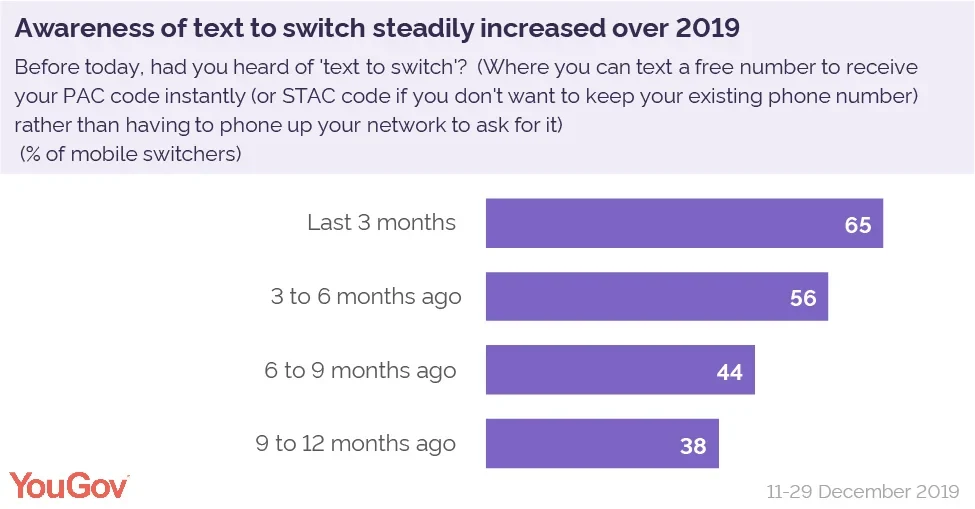Value for money and special offers are driving mobile phone customers away from conventional networks and towards no-frills alternatives
Between December 2018 and December 2019 seven per cent of the adult phone-owning population changed their network operator. This amounts to some 3.6 million people. But who left their existing network, and where did they go?
YouGov research reveals that mobile virtual network operators (MVNOs) MVNOs – the providers who use networksfrom the MNOs who have their own infrastructure - gained over half (54%) of mobile switchers, and lost just 37%, for a net gain of 17%. Meanwhile mobile network operators (MNOs) lost 63% and gained 46%, for a net loss of 17%.
While MVNO gains and MNO losses are both down on 2018 (where they were at 23% and 21% respectively), the data suggests that virtual network operators’ low-cost, no frills approach to mobile services, which are often just one among other services such as broadband and Pay TV, is continuing to pay off – at the expense of traditional networks
Hello operator: what’s driving mobile switchers?
MVNO and MNO switchers tend to give similar reasons for switching, but MVNOs outperform MNOs in certain key categories.
For example, more than four out of ten MVNO joiners (44%) said they did so because the tariffs represented value for money. It’s the top reason for changing to one of these networks, and also the joint top reason for switching to an MNO – but only three in ten (31%) cited this motivation: a 13 percentage point gap.
There’s an even larger gap among those who said they wanted the cheapest tariffs: over a third (37%) of MVNO joiners cited this reason versus 22% of MNO joiners. Smaller, but still significant gaps can be seen among those who said they wanted a tariff that met their needs (38% versus 31% of MNO joiners) and those who said they wanted the best offer or deal (33% versus 28%).
It is clear that amongst those operators that offer other service such as broadband or Pay TV (e.g. Sky, BT, or Virgin) these were also considerable drivers for joining. Upselling is clear and well.
The categories where MNOs tend to win out over MVNOs have more to do with technological and technical benefits: for example, a fifth (20%) claim they joined their MNO for the handset on offer vs. a tenth (10%) of MVNO joiners, 23% cited good data coverage (versus 20%), and 22% referenced voice coverage (versus 19%).
As for the kinds of tariffs switchers prefer, contracts remain the most popular and least popular option: almost half (48%) switched from a contract versus 44% who switched to a contract. SIM only contracts also saw net growth of 10 percentage points (22% switched to, versus 12% joined), while PAYG saw a net decline of 9% (20% versus 11%).
And while overall spend has increased year on year, switchers do tend to spend less with the network they join. In 2019, they were spending an average of £19.45 per month with the operator they left – and spent an average of £18.73 with the network they joined.
Adjusted for the entire population of phone owners, switchers used to spend around £70,000,000 a month, and currently spend £67,400,000 a month.

The impact of text to switch in the last six months
Text to switch, which makes it easy for consumers to get their PAC code from a provider with a simple SMS message, was brought into force by Ofcom in 2019.
Our data shows that consumer awareness of it has steadily increased. Almost four in ten (38%) who switched 9 to 12 months ago (December 2018- March 2019) were aware of text to switch, rising to 44% of those who changed provider 6 to 9 months ago56% of those who changed 3 to 6 months ago and 65% of those who changed in the last three months.
More importantly, this awareness has translated to action. Of those who switched six to nine months ago, almost six in ten (58%) called their operator versus just 13% who used text to switch – but for those who switched in the last three months, it was close to parity: 39% called the operator, while 37% used text to switch.
The brand that had the most success with text to switch was Sky Mobile: text to switch helped many consumers make the jump. Three in ten consumers (29%) used it in 2019 – rising to more than four in ten (42%) of those who switched in just the last six months.










